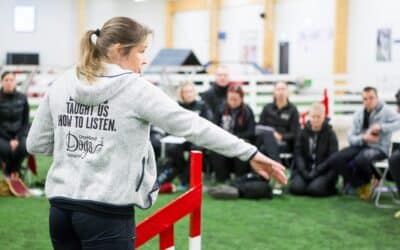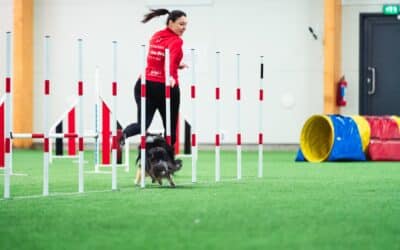Building a dog agility course in your backyard is a great way to give your dog an outlet to put their speed, smarts, and athleticism to work. Training and playing together builds an incredible bond between you, and is a great way to tire them out and keep them happy. Training agility at home can be a great way to get started in this fun and addictive hobby, as long as it’s done thoughtfully!
In this post, you’ll learn the basics of setting up a dog agility course in your backyard, so that you can get started as soon as you like. And we’ll cover how to lay the groundwork from the dog’s perspective with foundation skills such as those from the OneMind Dogs online Foundation for Agility program. You’ll also learn to set up a safe backyard course, focus on keeping things fun for you and your dog, build communication through handling skills, and prioritize fun and safety every step of the way. Let’s get started!
Why would you do backyard dog agility?
Backyard agility is just like the obstacle courses you see dogs competing on – only you get to set it up at home in your own yard or open space! It’s a great way to exercise and challenge your dog both physically and mentally without having to leave the house.
Do you have trouble finding agility classes near you? You’re not alone! People explore backyard agility for many reasons. Commonly, they don’t have the time to enroll their dog in a formal agility class, or there isn’t one nearby. Or they want to try it out before committing to a new activity with their dog. Setting up a dog agility course in your backyard provides a flexible option that is still incredibly rewarding for both you and your dog.
But more than anything, backyard agility is a way to have fun and bond with your dog.
Lay the groundwork before you build a dog agility course
Before setting up an agility course in your yard for your dog, lay the groundwork with some foundation training. These are the essential first steps every handler should consider before diving into full-on agility. Without even setting foot on any agility equipment, you and your dog have some vital (and super-fun) skills to master!
The most important aspect of training agility (or any new dog sport) at home, is to consider your dog’s health and wellbeing, both mentally any physically.
Consult your veterinarian
First, schedule a check-up with your vet to make sure your dog is physically ready for agility training. Look for the green light that there are no underlying joint, bone, or other health issues that could get worse with activity. You also want to make sure your dog is in an acceptable body condition to be tackling jumps and other obstacles.
Every dog is different, so speak honestly with your vet about your dog’s age, fitness level, joint health, and energy level. Let them know that you intend to set up a dog agility course and see what they recommend for your individual dog. For instance — high jumps, ramps and weave poles are not recommended for dogs under 12 months old (but there are still many foundation skills you could get started on instead). Older dogs may need modifications or additional rest between training sessions or to be built up more slowly.
Start slow and easy
Even if your dog is in perfect shape, let them work up to more challenging agility course elements over time. Start with short 5 minute sessions on flat ground doing foundation exercises that are both fun and simple for you and the dog. You want to build their confidence with early successes! Here’s a great example of such an exercise:
As you can see, you don’t need to build a full-on dog agility course with fancy equipment to get started with agility! Use everyday household objects like buckets and broomsticks to create obstacles for your dog to wrap around, jump over or weave through.
As you progress to more challenging equipment, keep obstacles low to the ground initially and keep repetitions minimal. If your dog ins’t having fun, it’s time to stop and rethink the exercise! Follow your dog’s lead on when to increase speed or difficulty.
Get more tips for starting agility from home with our free download – The Ultimate Agility Starter kit.
Learn the Foundation Skills
Before tackling a dog agility course, dogs need to master a few basic foundation skills such as forward focus, passing the handler, commitment to obstacles, following the handling, lead changes and more. These can be found in our Agility Foundation training online program.
- Forward Focus – Teaching the dog to focus on the obstacles on the line in front of them, rather than watching the handler all the time. This allows the dog to be independent which means you can work from a distance rather than running to each obstacle with your dog (because let’s face it, dogs are much faster than us!).
- Passing the handler – Teaching your dog that they can pass you and take obstacles independently builds confidence and allows the dog to progress on the course without relying on your running speed.
- commitment to obstacles – This is they key to you staying ahead on the course. IF your dog learns to commit to obstacles, you can “show and go”, keeping you one step ahead at all times.
- Following the handling – When the dog follows your handling on cue, you can direct them around the course more easily and cleanly.
- Lead changes – Dogs are left and right “pawed” just like humans are left or right handed. Helping your dog to perform lead changes smoothly at the start of your training will make things much easier for them later on.
Set Up your dog agility course
Once you and your dog have the foundation skills mastered, it’s time to set up some obstacles! When designing your backyard dog agility course, keep these elements in mind:
Choose a good location
Pick a flat, ideally shaded part of your yard to set up your agility field. Avoid concrete, stones, plastic or pavement under equipment – packed dirt, rubber matting or grass is best to prevent injury from slips and falls. Make sure the surface allows the dog to grip when they turn.
The space should be free of holes, debris, or obstructions in the running paths between obstacles. Make sure it’s adequatly sheltered from wind, rain, or harsh sun. Proper lighting and visibility are also crucial for safety, especially if you will be training in the early morning or late evening.
Select durable, safe equipment
While regulation agility equipment can be pricey, you can DIY obstacles from PVC piping and other household materials. Focus on smooth surfaces without sharp corners or points that could hurt your dog. Painting obstacles in high-contrast colors also helps dogs distinguish equipment from the backdrop where you are training.
No matter what equipment you use, double-check for stability, durability, and safety.
Adjust the course for your dog’s size and ability
Customize your dog agility course based on your dog’s skill level, age, and athletic capability. Beginners do best starting with a simple, straight line of 2-3 obstacles, with ample running room between them (6-9m or 20-30 feet). Keep jump bars low (below your dog’s hock height) to start with and simplify contact obstacles to set your dog up for success. Never set jump bars above the height of your dog’s withers. Remember the saying – Just because they can, doesn’t mean they should!
Focus on fun and bonding
In addition to physical activity, backyard agility is about mental stimulation and deepening the connection with your dog. Keep a positive outlook during training sessions, and make sure you both are enjoying the experience!
Keep training sessions short and positive
Limit early agility sessions to 2-3 minutes for young pups and 5-10 minutes for adult dogs. End each session after 2-3 successful repetitions to keep motivation high. Frequent rewards for effort, not just performance, build their willingness to try. Make sure to reward the dog if you make a mistake. Dogs follow our body language naturally, so if they went the “wrong” way, they misunderstood what you were trying to communicate. Reward the dog first and then think through how to better communicate the correct direction for your dog. Or better yet, video the training and send it to our coaching team for advice!
Quitting while you’re ahead keeps dogs confident and eager to train. Save some fun for next time, too!
Try different motivators and rewards
Experiment to see what most motivates your dog – chasing a ball, tugging a toy, treat, praise, cuddles etc. Letting your dog choose what they want to be rewarded with will help keep their interest high. Pay close attention to see which rewards they respond best to, here’s an example:
Are you ready to set up your dog agility course?
We hope that reading this got you excited to dive into backyard agility! It’s a gratifying activity for dogs and handlers. If you are feeling motivated to set up your own dog agility course, then our job is done!
If you’re still feeling a bit hesitant, we highly recommend some private coaching tailored to you and your dog’s learning needs, consult local agility trainers in your area to set up one-on-one lessons at home or working with a professional online coach such as our team at OneMind Dogs. Professionals can fast-track your training, troubleshoot any issues individual to your dog, and ensure you advance correctly to avoid injury risk.
Looking for more tips? Fill out the form below to sign up for our FREE 30-minute on-demand webinar “5 ways to make backyard agility training more powerful” 👇



